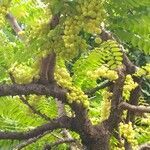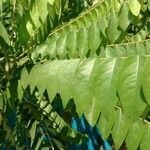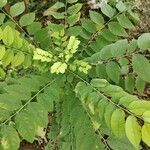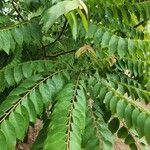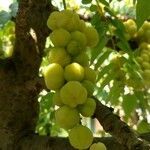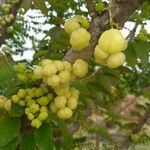A medium sized tree. It grows up to 2-10 m tall. It loses its leaves during the year. The leaves are smooth and 20-40 cm long and divided. The leaflets are light green and rounded at the base and pointed at the tip. The leaflets are alternate and pointed at the tip, rounded at the base and 2 to 7 cm long. Nodules develop on branches where leaves have fallen. Leaves tend to be clustered near the ends of branches. Flowers develop from these. Flowers are small and pink and crowded in clusters from these nodules. Male and female flowers are on separate trees. The fruit is medium sized, with 6 lobes, pale green but yellow when mature and sour. They are 1 to 1.5 cm across. The surface of the skin is smooth but the fruit are slightly ridged. It contains a bony hard grooved stone with 6-8 seeds.
Similar to P. reticulatus, but attaining 10 m. in height, with much longer leafy plagiotropic shoots (up to 60 cm. long) and larger leaves (up to 9 cm. long and 4.5 cm. wide), sepals in both sexes usually 4, ♂ and ♀ disc-glands usually 4, 4 free stamens, staminodes usually present in the ♀ flowers, ovary 3–4-locular, only 1 or 2 locules of which usually develop in fruit, fruit 1–1.5 cm. long, 1.5–2 cm. diameter, greenish yellow to whitish.
Similar to Phyllanthus inflatus, but with larger foliage leaves (up to 9 × 4 cm), floral whorls usually in 4’s, staminodes in the female flowers, fruit 1–2-locular, 1–1.5 × 1.5–2 cm, not inflated and more markedly fleshy.
